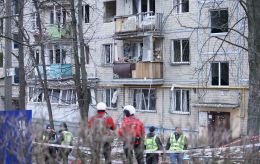Zelenskyy signs law on regulation of Crimea administrative-territorial structure
 Ukrainian President Volodymyr Zelenskyy (photo: president.gov.ua)
Ukrainian President Volodymyr Zelenskyy (photo: president.gov.ua)
President of Ukraine Volodymyr Zelenskyy has signed a law on changing the administrative-territorial structure of the Autonomous Republic of Crimea (ARC), according to the representation of the President of Ukraine in the Autonomous Republic of Crimea (ARC).
The head of the state has signed the law of Ukraine "On Amendments to Certain Legislative Acts of Ukraine on Resolving Certain Issues of the Administrative-Territorial Structure of the Autonomous Republic of Crimea."
The corresponding law was adopted by the Verkhovna Rada on August 23 - the day of the third summit of the Crimean Platform.
The bill was developed by the Representation in collaboration with the Committee of the Verkhovna Rada on the Organization of State Power, Local Self-Government, Regional Development, and Urban Planning.
"After the law comes into force - the day after its official publication, decisions adopted by the parliament in 2016 and 2020 on decommunization and the introduction of a new district division of the Autonomous Republic of Crimea will be implemented," the article states.
What is the purpose of the law
As explained by the Representation, the main purpose of the law is to lay the groundwork for the de-occupation of the temporarily occupied Ukrainian peninsula under Russian control. This is because "military and military-civilian administrations are being established to operate in the territory of territorial communities."
The law also instructs the Cabinet of Ministers to determine the territories and administrative centers of territorial communities in the Autonomous Republic of Crimea within 1 month.
Furthermore, the government is required to establish district state administrations (DSAs) for the new districts within 3 months and submit a draft law to the parliament regarding the specifics of restoring public authority in Crimea after its liberation.
"We believe that this step is crucial on the path to de-occupation and post-conflict recovery of the Crimean Peninsula," emphasized the Representation.
The council's decision on the administrative-territorial structure of Crimea
On August 23, against the backdrop of the third Crimea Platform summit, the Verkhovna Rada passed a bill amending the administrative-territorial structure of Crimea with 309 votes in favor.
As a result, decisions made by the parliament between 2016 and 2020 regarding the decommunization of place names and the introduction of a new district division in Crimea will come into effect. Previously, it was planned to implement such decisions after the de-occupation of Crimea.
The Council also supported a statement outlining the priority directions of Ukraine's state policy in the areas of liberation, reintegration, and recovery of the Autonomous Republic of Crimea and the city of Sevastopol.
De-occupation of Crimea
Official representatives of Ukraine have repeatedly stated that the end of the war with Russia can only occur with the full de-occupation of its territories, including Crimea.
As Kyrylo Budanov, the Chief of the Defense Intelligence of Ukraine, Major General, stated in August, Ukraine will definitely liberate Crimea from Russian occupiers, but it will require a ground operation.
In particular, the military path to de-occupying the peninsula has also been discussed by the Secretary of the National Security and Defense Council of Ukraine, Oleksiy Danilov.
In early September, Ukrainian President Volodymyr Zelenskyy mentioned that the issue of the de-occupation of Crimea can be resolved through military or diplomatic means, depending on the behavior of the enemy.

